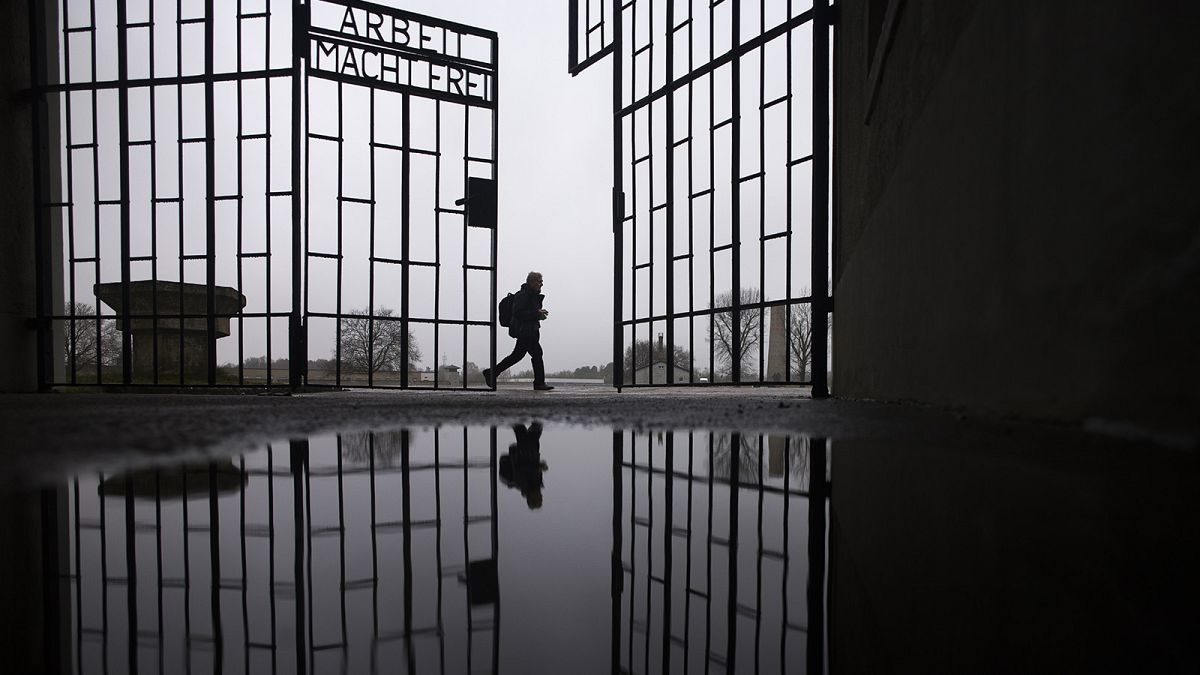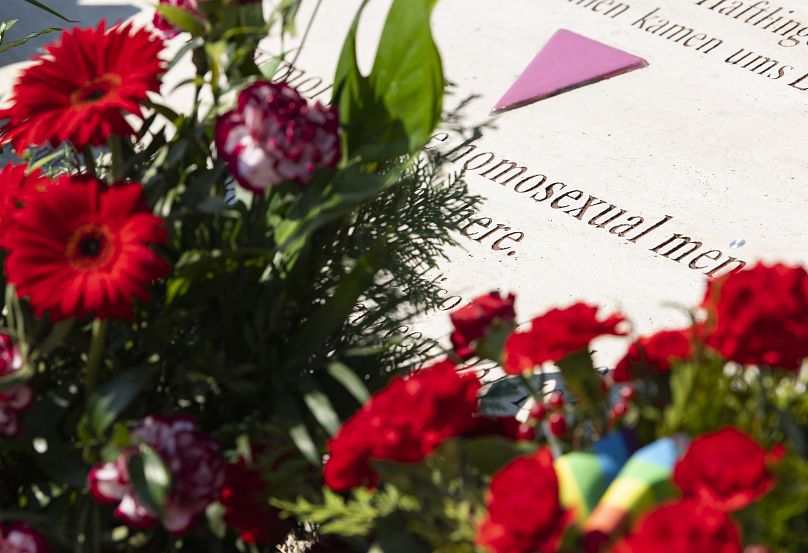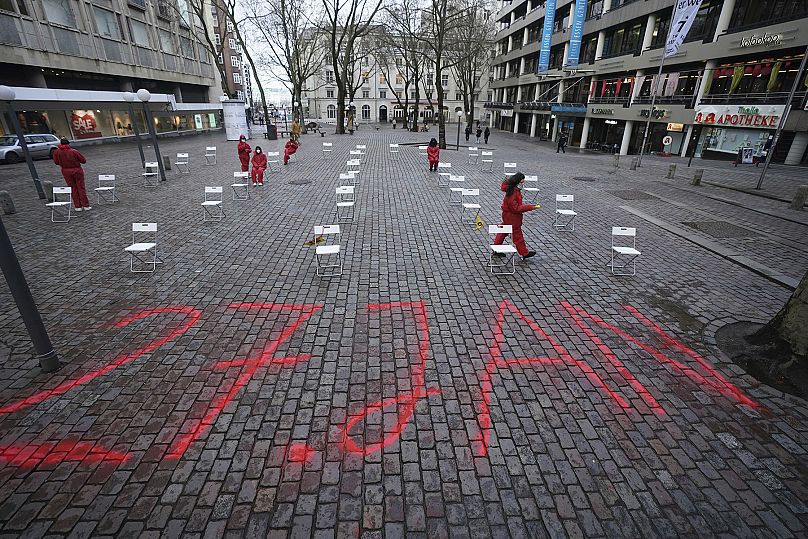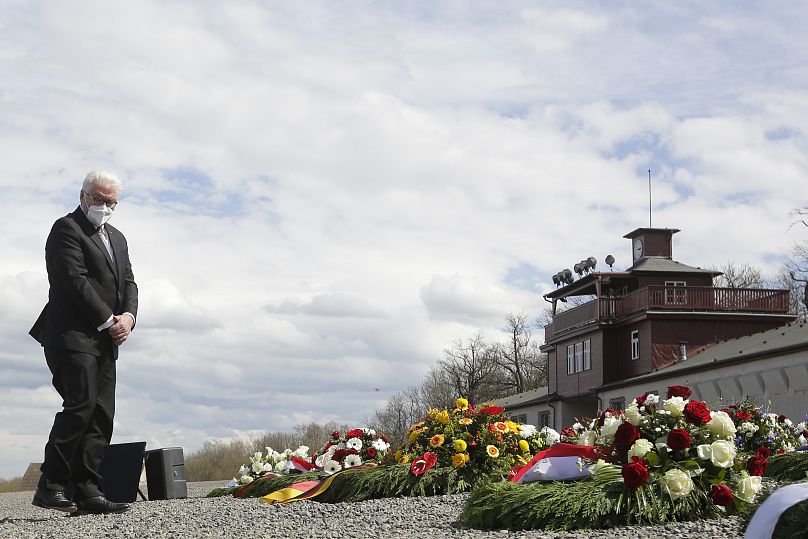As the world marks the International Day of Holocaust Remembrance, are Nazi Germany's LGBT+ victims finally receiving the recognition and commemorations across Europe that they deserve?
Today (27 January) marks the International Day of Holocaust Remembrance, an occasion to commemorate the victims — especially European Jews, the main targets of Nazi oppression — who were persecuted and murdered during the Third Reich.
First designated by the United Nations in November 2005, the day, just like the term "Holocaust" itself, has gradually come to subsume other victims under its umbrella, including Roma and Sinti communities, LGBT+ individuals and people with disabilities.
For the tens of thousands of gay people deported and murdered by the Nazis, the road to justice was winding and rocky, as they continued to face legal challenges after the Second World War and would only be properly acknowledged as Holocaust victims in the 1980s, 90s and — in the eyes of the German government — the 2000s.
As such, after decades of suppression and forced silence, are the Holocaust’s gay victims finally receiving the recognition and commemorations across Europe that they deserve?
How were LGBT+ people targeted by the Nazis?
Upon their ascension to power, the Nazis ruthlessly persecuted gay people throughout Germany and occupied territories.
Male same-sex intercourse had been prohibited in Germany since 1871 under Paragraph 175 — a Prussian-era statute of the national legal code — but it was considered to be only a misdemeanour, with the law being rarely enforced.
Indeed, Germany had represented something of a fertile ground for the development of new ideas surrounding sexuality and gender identity, being the country where the terms “heterosexual” and “homosexual” first cropped up and received recognition within academic circles.
In the 1920s and the 1930s, Mangus Hirschfeld’s sexology institute in Berlin -- Institut für Sexualwissenschaft -- pioneered research on sexual orientation and being transgender, and the new movements and magazines opposing Paragraph 175 and calling for new understandings of sexuality had even begun to attract the German middle classes.
But matters changed almost overnight when the Nazis came to power.
“We must be absolutely clear that if we continue to have this burden [homosexuality] in Germany, without being able to fight it, then that is the end of Germany, and the end of the Germanic world” — such words, uttered by SS Chief Heinrich Himmler in a speech in 1937, highlighted a new attitude towards homosexuality which the Nazis had ushered in.
Under the Nazi Party’s helm, the perceived moral “laxity” and permissiveness of the Weimar Republic was chastised and abruptly reversed.
Himmler in particular abhorred male homosexuality on account of its supposed ‘threat’ to the family values and purity of the German people in the eyes of the Nazi Party.
Organisations and networks were shut down, gay people were interrogated, and Paragraph 175 was revised in 1935, resulting in a massive upsurge of arrests and convictions.
By the end of World War II, between 5,000 and 15,000 men charged for homosexuality had been sent to camps, where, weighed down by the shame of the pink triangle or “Rosa Winkel” they often carried, they faced horrific abuse — including conversion therapy experiments and torture — and were ostracised by fellow inmates.
Lesbian women were not systematically targeted as they remained technically excluded from Paragraph 175, but faced a climate of hostility and were occasionally deported on the grounds of ‘asociality’.
Moreover, there are accounts of intersex inmates being used for medical experiments, especially at the hand of Auschwitz’s ‘Angel of Death’ physician and SS officer, Josef Mengele.
One renowned gay Holocaust survivor whose testimony sheds light on the predicament of the Nazi’s LGBT+ victims was Pierre Seel.
As a teenager, he was sent as a to Schirmeck-Vorbruck in 1941 after the Gestapo had gotten their hands on a local police list documenting him as a homosexual. There he recounts the terror he routinely faced — culminating in him having his lover executed before his very eyes.
“In the universe of inmates, I was a completely negligible element,” Seel wrote in his 1994 memoir, I, Pierre Seel, Deported Homosexual.
“Sexual crime is an added burden for a prisoner’s identity … [I] could be sacrificed at any moment, indifferently, depending on the random demand of our jailers.”
There was no justice for Holocaust victims in the immediate aftermath of the war.
Both West and East Germany upheld Paragraph 175, and the former even maintained its Nazi-era additions until 1969, resulting in approximately 100,000 arrests.
Certain gay survivors campaigned to receive recognition in the Vereinigung der Verfolgten des Naziregimes (Association of the Persecuted of the Nazi Regime), but to no avail. Homosexuals were essentially brandished as criminals and deviants, who on occasion were even forced to carry out their sentence after the war.
The added social stigma meant that many individuals like Seel concealed their identities for decades and were either coerced into unhappy marriages or risked public exposure and vilification.
Klaus Born, for instance, was one such individual who, in 1965, found himself entangled in West Germany’s homophobic justice system. In a fashion not too dissimilar to that of his predecessors under the Third Reich, he was arrested and sentenced at the age of 20 for being caught while having sex with another man.
Following the liberalisation of Paragraph 175 in 1969, and especially after the publication of gay Holocaust survivor Josef Kohout’s biography, The Men With the Pink Triangle, three years later there was a flurry of interest in the experiences of the Nazis' gay victims.
Alas, this did not immediately extricate victims from their plight or translate into acceptance, even among Holocaust Remembrance organisations.
It took the International Dachau Committee approximately a decade until it conceded to set up a memorial for Paragraph 175’s victims, following the incessant pleas of gay activists.
A reunified Germany would only strike Paragraph 175 down in its entirety in 1994, and officially pardon the Holocaust’s gay victims eight years later.
At a commemoration ceremony in Marseille on 27 April 2003, an increasingly frail 79-year-old Seel rallied for the acknowledgement of the Third Reich’s LGBT+ victims, a cause to which he had dedicated the last few decades of his life.
“I want to persevere, before I die, it’s my duty that homosexuals be recognised as deportees,” he stated.
Seel would pass away two years later, having finally received his recognition as a Holocaust survivor.
How are LGBT+ Holocaust victims commemorated in Europe today?
The road to justice was long and is far from complete, and it would only be in 2017 that the Bundestag decided to provide reparations for all of Paragraph 175’s survivors.
Across Europe, there are several memorials to the Holocaust’s LGBT+ victims. The first was established in 1984 at the Mauthausen camp in Austria, followed shortly after by the ‘Homomonument’ in Amsterdam.
In the 1990s, various concentration camps followed suit and erected various commemorative pink triangles, although there was initially some controversy over the inclusion of lesbian women among those persecuted.
Speaking to Euronews, Jens-Christian Wagner, a historian and director of the Buchenwald and Mittelbau-Dora Memorials Foundation, explained how the Buchenwald Memorial decided to commemorate its LGBT+ inmates since building a memorial in 2006.
The Buchenwald camp was the stage of a particularly cruel form of homophobic torture, as an SS doctor attempted to “cure” homosexuality with hormones, among other practices.
“We think it’s essential to commemorate the full scope of different groups which were persecuted by the Nazis,” Wagner stated.
“For this reason […] the fate of the prisoners who were sent to the Buchenwald concentration camp as [some 650] homosexuals plays an important part of our education work [in our permanent exhibition].”
Internationally and across Europe, organisations have officially come to acknowledge the Nazi’s LGBT+ victims and include them in commemorations.
Michelle Bachelet, the UN High Commissioner for Human Rights, released a statement for Holocaust Remembrance Day this year, asserting that “we commemorate the victims of the Holocaust, a crime of shocking inhumanity that brutally murdered six million Jews, as well as […] LGBT people.”
The Council of Europe moreover urged that “all the victims” — including “homosexuals” — be “taken into consideration”.
David Cupina, the President of Les Oublié-e-s de la Mémoire (The Forgotten Men and Women of Remembrance), a French organisation founded in 2008 to honour and defend the memory of the Nazi’s gay victims, told Euronews that awareness of this tragic chapter in the history of Holocaust significantly improved in recent years.
“Since we started, we have attended numerous commemorative ceremonies to honour the Holocaust’s homosexual victims — including at Natzweiler-Struthof in France — and have received a generally positive reception from most people, especially from politicians and academics,” Cupina stated.
He further added that “today we will deliver a message to the Council of Europe for its commemoration of Holocaust Remembrance Day, which would have been held in Strasbourg, and instead will be published on their website.”
The situation, however, remains far from perfect. As Cupina notes, not enough “educational” work has been done to raise awareness of the Holocaust’s LGBT+ history.
Aside from the fact that the commemoration of the Nazi’s queer victims is usually relegated to a passing mention, their names are still often missing from public memorials.
Indeed, Pierre Seel’s name is nowhere to be found at the Alsace-Moselle memorial which, despite not being a Holocaust museum per se, was erected to honour the region’s World War II history near the camp where Seel was interned.
“In certain Eastern European countries, where homophobic laws limit expression relating to LGBT issues, activists face a greater challenge,” Cupina concluded.
A 2020 survey from OSCE showed that in countries such as Greece, Romania, and Finland no primary or secondary education was provided on the "other" victims of Nazi persecution.
Furthermore, there was no teacher training on this subject in Belgium, France, Hungary, Luxembourg and Malta, highlighting that a significant amount of work still needs to be done.





